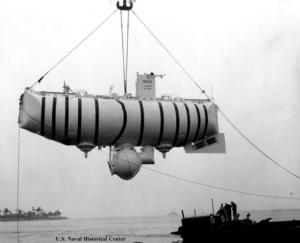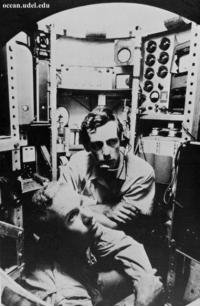 SKC Films Library SKC Films Library |
| SKC Films Library >> Naval Science >> Naval Architecture >> Submarines |
| Trieste [trE' est a] the first manned vessel to ever descend to the absolute bottom of the world In 1932, Swiss scientist Auguste Piccard reached an altitude of 55,800 feet in a specially built balloon equipped with a pressurized cabin he had designed, setting a new record. His record was subsequently broken by other balloonists using similarly designed cabins. Having literally achieved new heights, Piccard next set his sights on achieving a new low, a descent to the deepest point on earth. Using many of the same principles he had used in his balloon and balloon cabin, Piccard designed a bathyscape capable of making dives to great depths without having to rely on a cable. His first prototype conducted a successful unpiloted dive in shallow water (80 feet) on October 26, 1948. On November 3, 1948, in a deeper dive of approximately 4,600 feet, the cabin withstood the pressure perfectly, but the float was severely damaged by a heavy swell of water that it encountered after the dive. The project was plagued by various other difficulties before Jacques Piccard joined in his father's quest. Working together, the two men designed a second prototype, the construction of which was subsequently financed by the Italian city of Trieste. Thanks to that city's financial support, the Trieste was launched into the Mediterranean Sea near the Isle of Capri on August 26, 1953. The bathyscape spent the next few years in the Mediterranean before being purchased by the U.S. Navy in 1958. The U.S. Navy purchased the Trieste for the sole purpose of achieving Auguste Piccard's dream of reaching the bottom of the sea. Too old to make the descent himself, Auguste sold the Trieste on the condition that Jacques be allowed to accompany whomever the Navy chose as the planned mission's commander. The Navy agreed to the condition. the Trieste soon after its purchase by the U.S.
Navy The Navy made extensive modifications to the Trieste so that it could better withstand the extreme pressures it would be subjected to. Other modifications gave the Trieste better maneuverability when submerged. Overall, however, the bathyscape retained most of Piccard's original design. The vast majority of the vessel's 59.5-foot length was taken up by a series of floats filled with 22,000 gallons of gasoline, water ballast tanks at each end, and two hoppers loaded with 9 tons of iron pellets. The two-man crew would take its journey inside a 6.5-foot-diameter sphere attached to the bottom of the fuel/ballast float. The huge float was necessary because it was not possible to design a sphere large enough to hold a person that could capable of withstanding the great pressures of the ocean depths without being too heavy to remain neutrally buoyant. Gasoline was chosen as the float fluid because it is lighter than water and incompressible even at extreme pressure. The water ballast tanks were used to aid in the Trieste's descents, while discharge of the iron pellets allowed it to resurface with relative ease. The pellets were held inside the hoppers with electromagnets, meaning that an electrical failure would automatically release the pellets and allow the craft to ascend. After a series of deep-submergence tests in the Pacific, the Trieste made its first record-breaking dive on November 15, 1959, reaching a depth of 18,600 feet (the old record was 13,000 feet). It broke its own record on January 8, 1960, with a dive of 24,000 feet. Having proven itself, the Trieste was deemed ready for the most ambitious dive ever undertaken. The dive that made the Trieste famous penetrated the very deepest part of the oceans, an area of the Mariana Trench (off Guam) known as the Challenger Deep (named for the ship which had discovered it in 1875, the HMS Challenger). It was made by Jacques Piccard and U.S. Navy Lieutenant Donald Walsh on January 23, 1960. It took 4 hours and 48 minutes for the Trieste to reach the bottom of the deep, 35,800 feet below the surface. The men spent about 20 minutes on the bottom, during which they recorded seeing shrimp, a few fish, and "diatomaceous ooze." The return to the surface took 3 hours and 17 minutes. Walsh (foreground) and Piccard
aboard the Trieste during its record dive The Trieste underwent even more renovations after its historic dive, to the point that very little of the original vessel was left by the time it made its last dives. Those dives were made in the Atlantic in 1963, as part of an extensive search for the lost submarine USS Thresher. The submersible was taken out of service soon after the Thresher was found, and is now on display in the Navy Museum at the Washington, D.C., Naval Yard. Piccard and Walsh remained the only people to ever reach the bottom of Challenger Deep until March 2012, when film maker James Cameron made a solo dive in the Deepsea Challenger. No other manned vessel has come anywhere close to achieving that depth. INTERNET SOURCES SEE ALSO |
| SKC Films Library >> Naval Science >> Naval Architecture
>> Submarines This page was last updated on 06/21/2017. |

